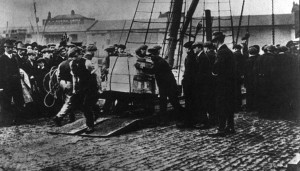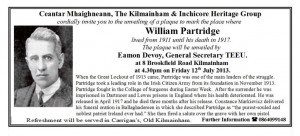Living The Lockout
Great ‘Living the Lockout Podcast’ based on Tenement experience – click on to link below

Great ‘Living the Lockout Podcast’ based on Tenement experience – click on to link below
(Text of speech at Wreath laying and Poetry Reading in Memory of Francis Ledwidge, Poet and Soldier, National war Memorial Gardens, Islandbridge, Dublin, August 4th, 2013, by Padraig Yeates)
August 4th, 2013, is 99 years to the day since Britain declared war on Germany in the conflict that became known as the First World War. It would devastate much of France and Belgium, northern Italy, the Balkans, Central and Eastern Europe, as well as destroy the Ottoman Empire, give birth to the Soviet Union and the international Communist movement, and facilitate the rise of the United States to super power status.
An estimated ten million people died in Europe alone and it created the conditions that led to the Second World War and the deaths of 50 million more across Eurasia within a generation. Most of the crises and conflicts we face today can trace their roots to the ‘guns of August’.
Francis Ledwidge was one of those millions of combatants who died in the Great War. He was ‘Killed In Action’ on 31 July, 1917, one of a group of Royal Inniskillings designated to work as pioneers on communications trenches and roads in preparation for the Third Battle of Ypres. ‘Killed In Action’ is of course a euphemism designed to obscure the obscenity of industrialised warfare and production line slaughter. He was reputedly drinking a cup of tea and smoking a cigarette when a German artillery shell sent him and four comrades into oblivion. It was probably as good a death as anyone could hope for on the Western Front in 1917, and my father used to say you weren’t supposed to hear the one that got you. (more…)
By Gary Granville
The O’Brien Press
€9.99
http://www.obrien.ie/dublin-1913
Gary Granville’s Dublin 1913: Lockout & Legacy is an expanded edition of a book originally published in 1978 under the title Divided City: Portrait of Dublin 1913. While the new choice of title is easily understood considering the obvious desire of the publisher to capitalise on the current centenary year of the 1913 Dublin Lockout, it is the opinion of this reviewer that the original title was actually more appropriate.
For Granville’s book is not just an account of 1913, but rather a study of the great divisions that existed in Dublin society during the early 1900s: divisions which were then vividly highlighted during the epic industrial dispute. Furthermore, the wonderfully evocative range of photographs and other visual imagery utilised throughout effectively combine with Granville’s text to indeed offer a portrait of Dublin in 1913.
The fact that James Larkin does not appear on the scene until over halfway through the main narrative is indicative of the fact that Granville has compiled a multi-dimensional view of Dublin social history at the beginning of the twentieth century, rather than a labour history book focusing solely on the Lockout. (more…)
http://
The Exhibition, “A Tale of Two Cities” is a kaleidoscope of images from the disease-ridden tenements to balls in Dublin Castle and will be on display in the Dublin City Library and Archive, Pearse Street, from 5th to 23rd August.
Below: Grand Parade of Coaches at the Dublin Horse Show
Fintan O’Toole review in Irish Times July 22nd 2013 on Living the Lockout
Lowe, Boss, sound designer Carl Kennedy and costume designer Niamh Lunny are smart e![]() nough to allow the house to exert its own grip. They use two high-ceilinged rooms and one claustrophobic corridor to stage three relatively short scenes that, with skilful economy, contain the history of the Lockout as experienced by the occupants of the house.
nough to allow the house to exert its own grip. They use two high-ceilinged rooms and one claustrophobic corridor to stage three relatively short scenes that, with skilful economy, contain the history of the Lockout as experienced by the occupants of the house.
In the first, Lloyd Cooney and Eric O’Brien play two brothers who are members of Jim Larkin’s locked-out union. They are pumped up by the heady, revolutionary euphoria of the early days of the action, both repelled and excited by the violence of Bloody Sunday, when the police baton-charged peaceful citizens, and the riots that followed. For the second, we enter a darkened room in which a mother is putting two sick children to sleep in a big wrought-iron bed – an image clearly inspired by a now-famous photograph of children in a tenement interior. The mother is played, very touchingly, by Laura Murray, whose monologue is partly based on her own grandmother’s letters. It raises the darkest question of the Lockout: is it better to fight for justice while your children starve or to end the suffering by knuckling under? The third scene, in the corridor, plays out that conflict between the two brothers at the end of the Lockout, as one submits and the other insists on fighting on.
As well as being gripping and immediate, the drama is strikingly complex. It plunges us into human dilemmas – the attraction and repulsion of violence, the frightful cost of struggle, the tensions between individual and collective imperatives. It is deeply concerned with the dignity of the people it portrays, yet utterly devoid of heroic rhetoric or cheap sentiment. It shows, in 35 highly charged minutes, how memory does not have to be morbid and how thoughtful commemoration differs from mindless celebration.
Living the Lockout plays seven times a day at 14 Henrietta Street, Dublin 1, until August 31st. dublintenementexperience.com
fotoole@irishtimes.com
See the link below for a taster
 http://audioboo.fm/boos/
http://audioboo.fm/boos/
A six part documentary series narrating the events that led to the labour versus capital conflict in Dublin in 1913, exploring the leaders on both sides and questioning the legacy of Lockout 1913 for Ireland today. The series begins on August 10th on RTÉ Radio 1. The series is an Athena Media production made with the support of the Broadcasting Authority of Ireland Sound and Vision Scheme. The producer/presenter is Helen Shaw, the audio editor is Amy Millar with original music by Michael Gallen.
Christopher Lee, author of an article on Finglas, County Dublin, in the 1913 Lockout has written an excellent article on events on Swords
Christopher Lee, author of an earlier article on Finglas, County Dublin, during the 1913 Lockout has now followed up with an excellent story of events in Swords. Here is a taster:
Windows up and down the darkened street are smashed by the rioters, a hail of stones and bottles shattering every window in the police barracks. A line of police advance into a barrage of bottles and stones, some felled by the projectiles as they move on the crowd; suddenly the police surge forward, batons raised, swinging as they wade into the milling, surging crowd of men…
To read the full story go to http://www.theirishstory.com/
 William Partridge, one of the leaders of the 1913 Lockout, was honoured in Inchicore on Friday, July 12th by residents and public representatives in one of many events organised this year by local historian Michael O’Flanagan.
William Partridge, one of the leaders of the 1913 Lockout, was honoured in Inchicore on Friday, July 12th by residents and public representatives in one of many events organised this year by local historian Michael O’Flanagan.
Partridge was a key link between the traditional craft unions, the newly organised Irish Transport and General Workers Union, the advanced nationalist and revolutionary socialist movements in the city. He also represented Kilmainham as a Labour councillor on Dublin City Council, fought in the 1916 Rising and died at a tragically early age from Bright’s disease, contracted in prison in 1917.
Below is a link to the unveiling of the plaque in his honour at his former residence, 8 Brookfield Road, Kilmainham on Friday, July 12th